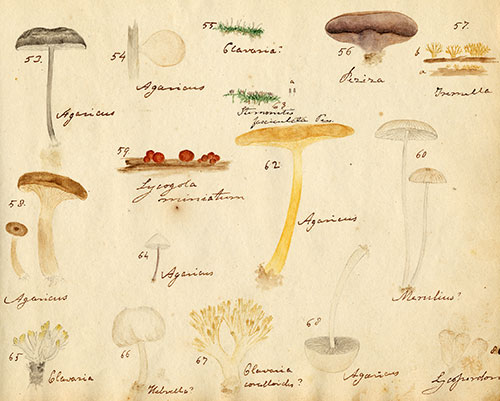Impressions from a Lost World: The Discovery of Dinosaur Footprints
Botany in the New World

Fungi selcti picti, Orra White Hitchcock, 1821, page 3. Image courtesy of Smith College Special Collections.
In the 18th century, the American colonies were still raw and new and lacked the Old World’s vast libraries, universities, and museums, but in compensation, this New World provided fields to delight an avid plant collector. The North American continent provided a staggering bounty of new and unusual plants and animals, and the Old World was hungry for specimens. Americans collected local plants and sent them to botanical experts in Britain and Europe to be classified, illustrated for publication, and added to museum collections. Networks of correspondence and exchange between Americans and Europeans grew, to the benefit of both: Europeans acquired the new material they wanted, and Americans were lauded as the local experts with something unique to contribute to botanical (and other) science.
Adventurous young men with a bent for nature could forage for interesting specimens for shipment overseas. A few, such as the great American botanist John Bartram, were able to make a living from it and were furnished with tools and books by Carl Linneaus and other correspondents eager to have his discernment in selecting the specimens they desired. Bartram also sent seeds that were used to cultivate American plants in Europe. Such intellectual stimulation connected Americans in rural areas with city dwellers, giving them status for their expertise on local plant life.
Botanizing became popular in the 19th century. It required no special training or expensive equipment, it was free, it provided opportunities for healthful socializing outdoors, and it fostered an appreciation of God’s creation. All that was required was a way to cut or uproot specimens and something as simple as a pocket or a cloth bag for carrying them. Some people enjoyed merely collecting and identifying species. Others, like Edward and Orra Hitchcock, created herbariums, affixing specimens to heavy paper for preservation and arranging them into categories. They took pleasure in knowing that they were contributing to the general fund of knowledge, similar to nature lovers today who participate in Audubon’s Christmas Bird Count, or who notify NASA of a meteorite fall, or who confer with paleontologists about their fossil discoveries.
For women, botany was considered safe and edifying. Partly, this was due to traditional associations with love and beauty and partly to its domestic uses. Men might bushwhack into wild places, but women could collect and identify plants from their own gardens and those of their friends, or might, with masculine accompaniment, go into the pastures, fields, and forests near home. For many, the pleasure was in identifying different kinds of plants and knowing their uses as medicines, dyes, animal feed, and cooking. Botanical drawing was also an approved outlet for women. A few of them, like Orra Hitchcock, published their botanical art in medical books and journals. Even as early as the 1750s, Jane Colden, the daughter of physician Cadwallader Colden, who served for a time as Lieutenant Governor of New York, was impressing the experts overseas with her contributions to their understanding of the plant life of her region.
Until the last quarter of the 19th century, amateurs and the growing number of professional botanists worked in tandem, sharing specimens and advice, reading the same journals, and belonging to the same organizations. Once the major work of collecting had substantially progressed, however, professional botanists turned their attention to biology, and a few to plant paleontology, both of which demanded laboratories, equipment, academic expertise, and training. Professionals began to develop a specialized language that amateurs did not use or understand. Formerly considering themselves colleagues on a single endeavor, “botanizers” began to divide into researchers and hobbyists, and amateurs fell out of the professional network.